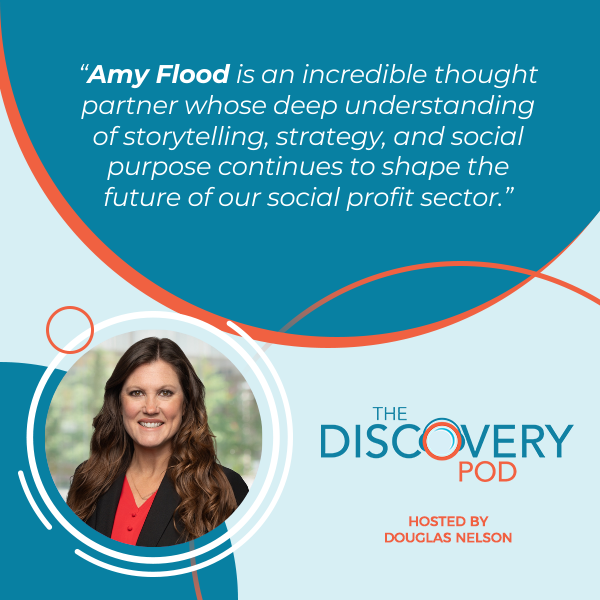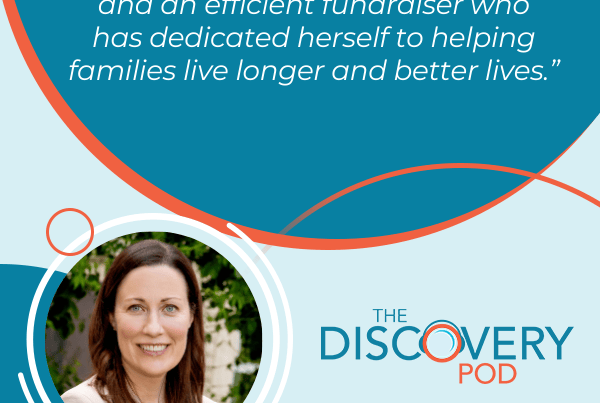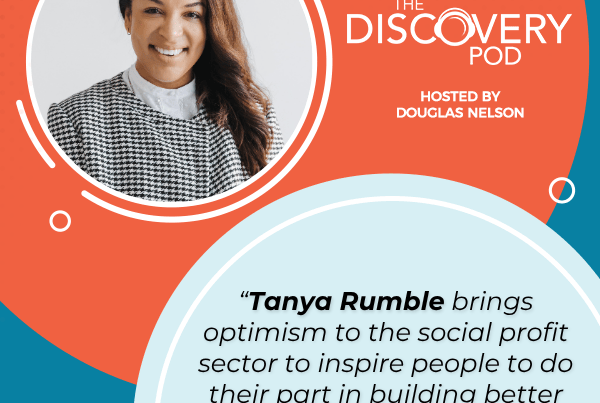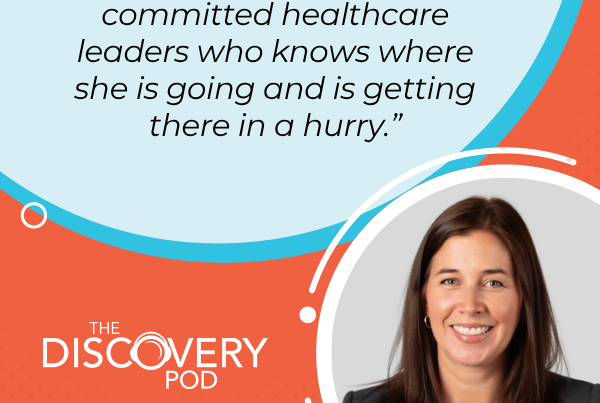
Women’s health in Canada is critically underfunded—only 7% of national health research dollars are dedicated to it, and just 2.5% when oncology is excluded. Amy Flood, Executive Director of Women’s Health Collective Canada, joins the conversation to share how her organization is tackling this disparity through strategic partnerships, policy advocacy, and public education. From pushing for a national health care strategy for women to advance gender-based research standards, Amy highlights the urgent need for systemic change. She sheds light on the staggering $3 to $3.5 billion annual cost of unmanaged menopause symptoms, the power of making health inequities personal, and the role of evidence-based information in combating misinformation. With a growing global focus on women’s health, Amy calls for collaboration across sectors to position Canada as a leader in women’s health innovation.
—
Listen to the podcast here
Strategic Partnerships And Policy Advocacy With Amy Flood, Executive Director, Women’s Health Collective Canada
As we kick off our Women’s History Month series, we’re proud to spotlight a leader whose work and lived experience continue to shape the future of our social profit sector. Our guest is Amy Flood, Executive Director of Women’s Health Collective Canada. Amy leads a national collective advancing women’s health through shared research, aligned fundraising, and strategic partnerships. Before this role, she led corporate partnerships at Heart and Stroke and Canada’s Children’s Hospital Foundations, and brings over eighteen years of branded marketing experience from the private sector.
Amy’s deep understanding of storytelling, strategy, and social purpose makes her an incredible thought partner. In this episode, she shares the essential balance between advocacy, engagement, convening, and fundraising. If you’re trying to do any of those things in your organization or need to do any of them better, you’re going to want to listen to this great episode, this great wisdom that Amy shares. Thank you for tuning in to The Discovery Pod. Please enjoy this episode.
—
Welcome to the show, Amy.
Thank you, Douglas. It’s great to be here. Thank you for inviting me. I’m looking forward to our discussion.
It’s not always that the topic of the show is as topical as women’s health, but it’s certainly an issue that is on the top of many people’s minds, top of the list of discussion when it comes to health care overall. Really looking forward to getting into how you and your colleagues across the country are advancing women’s health and raising awareness about it. First, tell me a little bit more about what Women’s Health Collective Canada is, who you serve, and how you do your great work on a daily basis.
The Mission: Unpacking Women’s Health Collective Canada
Women’s Health Collective Canada is a national alliance of leading women’s health foundations, research institutes, and hospitals, working together to close the gender gap by funding critical research, advancing education, and driving systemic change in health care. The unique thing about us is that our impact is a full cycle. What I mean by that is we raise funds for women’s health research that can go through clinical trials right into our care centers and then ultimately change standards of care right at our affiliated hospitals and beyond. Our goal is to ensure that women’s unique health needs are no longer overlooked, underfunded, or misunderstood.

Strategic Partnerships: Women’s Health Collective Canada is a national alliance of leading women’s health foundations, research institutes, and hospitals, working together to close the gender gap by funding critical research, advancing education, and driving systemic change in healthcare.
Really powerful message, powerful work that’s going on a daily basis. I’m curious, given your background, you’ve worked in a national health organization before, and you worked in marketing communications in the private sector as well. What drew you to this role that you are playing there at the Women’s Health Collective?
I think what’s fantastic about this organization is that we work with corporate partners and organizations in the private sector to help fund and invest in research that leads to tangible improvements in care and outcomes for women. It’s not just about government funding. It’s about really engaging the private sector and corporate partners to help in that journey.
We do this by raising education and awareness about the gender health gap and women’s health issues and by being a trusted source of high-quality evidence-based information, not just for women, but for their colleagues, their partners, their family, and Canadians at large. Beyond funding, WHCC works in partnership with healthcare leaders, researchers, and policymakers to push for systemic change, whether through more inclusive public policy, stronger investment in women’s health research, or greater integration of sex and gender-based knowledge in the healthcare system.
Fun fact, not fun, but I think what drives me is the notion that only about 7% of national health research funding in Canada is currently directed to women’s health. If you remove oncology from that, this number is more like 2.5%. With women being 50% of the population and 3% of our overall funding from the government going to women’s health research, it’s really important that we engage the private sector.
Only about 7% of national health research funding in Canada is currently directed to women's health. Share on XWe must tap into marketing and communications to make sure that that gap is understood and that people are really inspired and engaged to join our movement and help us fund the facts. By working together with a bunch of different alliances and organizations, we aim to change this systemic inequity and build a healthcare system that truly meets the needs of women.
The Staggering Truth: Funding Disparity In Women’s Health Research
Amy, it’s just staggering to hear that number, 7% or 2.5% directed directly into women’s health. What do you hear from people when you tell them that, whether it’s corporate funders or potential donors to your organization or your member organizations? What do people say when they hear those numbers?
Really shocked and a sense of confusion, and a lack of understanding as to why we’ve arrived where we are. The question always comes up, why? Why is there such an inequity in the healthcare system, and why is the funding so low? The answer is just as shocking. Up until 1997, women were not included in clinical trials for health research. It was just assumed that women were just smaller, miniature versions of men, and it was not necessary to conduct research on our bodies.

Strategic Partnerships: Until 1997, women were not included in clinical trials for health research, and it was just assumed that women were miniature versions of men.
Within that, they’re not taking into account our biology, our genetic makeup, the hormonal journey that we go on through life. It’s a real education process. There’s really a lack of understanding and knowledge that this gap is there. To go even deeper and explain the why, it becomes very surprising. It becomes very motivating. People seem to want to get on board and help with the change.
I know from work that we do in the sector, the difference in health outcomes for women, particularly when it comes to areas of cardiac and stroke, is significantly worse than men. It’s not hard to imagine that there’s a connection between viewing women as just smaller men and their health outcomes not being as good. It’s not just about equity, though. That’s not reason enough to be outraged and to be advocating for change. There are real health implications for women in Canada.
No, absolutely.
Beyond Funding: The Evolving Strategy Of Women’s Health Advocacy
What do do about it? You can shock people with that number. It could be because it is shocking. Where does the conversation go from there?
There’s a lot that we can do. I think first and foremost, when WHCC was first established, we were primarily a fundraising organization. With the trends that we’ve been identifying and with the work that we’ve been doing, it has become really evident that we need to evolve our strategy to be more encompassing. Our three-year strategy and our plan that we’ve aligned to now is that we’re moving beyond just fundraising into building strategic alliances and partnerships with other like-minded organizations.

Strategic Partnerships: Our three-year strategy and plan now is that we’re moving beyond just fundraising into building strategic alliances and partnerships with other like-minded organizations.
We’re moving into that education and awareness channel and pillar to make sure that we’re driving the awareness of the gap, but as well that we’re providing evidence-based information for women at large so that they can know there’s a trusted source of information around their conditions, around treatments, around standard of care and what to do.Beyond that, we’re advocating for systems change.
In addition to fundraising and education, we advocate for change at the system level by pushing for policy change and public investment in research and programs that support women’s health across Canada. We’re moving into this space and really trying to work with the federal government and the provincial governments to implement policy change and develop a national healthcare strategy for women that can be held accountable and is measurable, and is something that will actually drive the systemic change that is necessary.
I would imagine you have a pretty open path when the difference in funding or the inequity in health funding is apparent. Talking to policymakers or elected officials, I would imagine no one’s saying, “We’re not going to do that.” What are they saying or how fast are they moving?
It’s a great question, and the answer is not that simple. I think really the answer becomes, where does the money come from? No net new money is going to be coming into the economy and the system. Therefore, it’s if you’re recommending systemic change and you’re recommending policy, then where is the money coming from? Those are the conversations that are going to begin now.f That’s where these strategic alliances with other women-led organizations are necessary so that we can demonstrate the economic impact of improving women’s health and women’s health research so that it’s not just a now impact, it’s an impact for the future. I think that’s the road ahead of us.
What you’re hearing is, “Yeah, sure, we hear you, now you tell us what we should do about it?”
Exactly that.
What are you telling them?
We’re telling them that there is a need for increased federal funding for women’s health research. It remains underfunded, and the gaps in the knowledge and treatment are going to be a systemic problem for the long term. We need a national strategy for women’s health. Canada lacks a coordinated approach to addressing women’s health inequities, and a national strategy would set measurable goals for research, healthcare delivery, and policy reform. Largely, the enforcement of gender-based research standards in CIHR-funded studies.
Compliance with sex and gender-based analysis in federally funded research is inconsistent. Stronger enforcement and mandatory reporting on sex and gender differences will improve research quality and ensure findings. Translates to better care for women. We’re telling them that it needs to be more inclusive, and it needs to start now because as evolutions, innovations, and research move forward, we’re going to be left even further behind.
At the end of the day, I think that the biggest piece is that Canada currently ranks 63rd on the whole logic global women’s health index, not where you’d expect us to be for a G7 nation, and far behind many of our OECD peers. This ranking reflects real gaps in our system. At the end of the day, ongoing issues are the failure to fully recognize the financial and economic value of women’s health. We make up over 50% of Canada’s population.
We pay taxes, we support families, and contribute to every sector of the economy. When women are unable to access timely, appropriate care or live for years in poor health, the consequences aren’t just personal. They’re systemic. There’s missed work, lost productivity, unpaid caregiving, and increased healthcare costs. This all adds up, and yet these economic impacts are rarely quantified or taken seriously in healthcare planning and public policy.
Interesting fact. The cost to the Canadian economy of unmanaged menopause symptoms alone is estimated to be $3.5 billion a year. We’re working to change that not only by supporting new research to better understand these costs, but also by raising the profile of these issues across sectors. This includes partnering with colleagues and experts across Canada to generate evidence and start new conversations about the economic case for investing in women’s health.
The cost to the Canadian economy of unmanaged menopause symptoms alone is estimated to be $3 to $3.5 billion a year. Share on XMaking It Personal: Connecting Data To Lived Experiences
I always get a little grouchy when there is a health and an equity argument and we end up having to justify it on economic grounds, but it’s helpful to have all three. I think the first two should be sufficient, but I appreciate you walking us through that. One of the things I’m curious about, so in our work here at The Discovery Group, we work with a number of organizations that have advocacy as a part of their primary mandate.
They’re working with different levels of government, usually the federal and provincial governments are both. It’s always a challenging balance to not spend too much of your time on advocacy, too much of your time focusing on broadcasting to that particular audience, because it is a different tone of voice than what you want to be broadcasting to the general population. As a relatively new organization and with such a clear mission in your work, you’ve identified raising public awareness, which can be so challenging for organizations.
I know you’ve witnessed other organizations that struggle because they talk about awareness, but they don’t really have a sufficient or clear enough target for the awareness they’re trying to raise or what action they’re trying to inspire. How have you connected that really clear data-driven case you’ve just shared with us to that public awareness, to those advocacy efforts in a way that is focused enough to move the needle and general enough to attract the attention of the general population?
I think when it boils down to it, you need to make it personal. This is not only the right thing to do, it’s the smart thing to do. Improving women’s health strengthens our economy and our country. A healthier population drives productivity and economic growth. With the growing field of women’s health technology, or Femtech, there’s an enormous opportunity for innovation and investment. It’s an exciting opportunity-filled space, and the time for action is now.
Improving women's health strengthens our economy and our country; a healthier population drives productivity and economic growth. Share on XI think when you’re boiling it down to appealing to the general population. I would hope that includes policy leaders and folks in the federal government. Everyone has a mother, a wife, a sister, a colleague, a cousin who is experiencing these inequities within the healthcare space.It’s not just about research. It’s about the standard of care.
It’s about wait times. It’s about misdiagnoses. It’s about lost productivity in the workforce. It’s about constantly having to juggle the mental battle of being a mom and somebody who is in a high-profile job while planning rugby trips for the city rugby team. You cannot help but understand and realize why women are facing mental health challenges.
They’re pulled and strained in every which way, and the system has let them down. Quite frankly, we just need a better standard of care from soup to nuts. That starts with understanding how hormones affect your body, your mind, your thought process, your emotions, and how you live day to day, and we’re 51% of the population. If people cannot see that, then we need to show it to them. We need to show it through lived experiences and testimonials, and people coming forward.
That’s what I’m so hopeful about right now is that this is a boiling point moment where women are uniting, they’re speaking out, they’re turning to social media female doctors, female obstetricians, gynecologists are coming out in social media and they’ll they’re helping educate and helping inform people on on what the cost of this is to the people they love so much. I think making it personal for everybody to understand is the best surefire way to break through.
It sounds like part of what your messaging is to let women know that they can expect more, to insist on more, and to advocate for their own health in the system as it is, and advocate for the changes to make it more accessible for themselves.
We always encourage women to advocate more for themselves. Part of that is bringing someone with you. Bring someone with you to a health appointment. If you’re juggling so much that you cannot even focus on your own health, and you cannot focus on what the narrative is coming towards you, bring somebody with you to advocate for yourself, to push for the questions, to make sure that the answers are clear. If you’re not getting the right answers, you have somebody with you to push to go back and ask for more answers.

Strategic Partnerships: We always encourage women to advocate more for themselves, and part of that is bringing someone with you to a health appointment.
I think women are just so bombarded today that they never prioritize themselves, and they never put themselves first. Not only do they need to advocate for themselves, but they need to bring people with them who are in their corner and can translate for them and can help them focus and can help them reach the treatments, the diagnosis, the information that they need and deserve, and they need to realize that they need it and deserve it.
The cause is clear, and hopefully, the progress can be as certain. Again, our work, their organizations, health foundations in Toronto and Calgary and Vancouver, and Halifax, that have taken on menopause and the menopause journey as an area of focus, a very prominent area of focus for fundraising. Very positive to see a conversation that needed to be had, that was often silent or not had. What do you see? What are you learning? What are your member organizations learning from the process of presenting menopause as a fundraising opportunity, seeing dollars come into it? What does it mean for the larger movement?
Menopause & Beyond: Unlocking Deeper Insights Into Women’s Health
I think that we’re learning a lot from menopause as a journey itself because menopause wraps up a whole life stage. When you think about it, it starts right from the moment an individual or a young woman menstruates, which is happening earlier and earlier at the age of 9 or 10, and it can go all the way into your 70s. There are many different phases of it. There’s your reproductive years, there’s your late productive years, there’s paramenopause, there’s menopause, there’s post-menopause.
I think really what it’s starting to highlight is it’s that hormonal journey and the genetic makeup and how different women are. This particular phase in our lives is starting to shed light on that. That’s starting to shed light on the cross-cutting conditions that are associated with a hormonal journey. That’s mental health, that’s physical health, that’s weight gain, that’s how you diagnose and understand everything. I believe that menopause, being a truly feminine female condition, is shining a light and shedding light on all of the other areas within women’s health that are untouched, and how many more rabbit holes there are really to go down.
I think a thing that we typically look at or a way in which we typically look at research for women, is there are conditions that affect women more than men. There are conditions that affect women differently from men. Some conditions affect only women. It’s not just about the gynecological factor within women. If you look at cardiovascular and you look at the way heart and stroke, for example, present in a woman, our bodies, our makeup are completely different. Conditions show up differently. Treatments need to be different.
The standard of care needs to be different. I think menopause is actually really opening up that Pandora’s box and really opening up people’s eyes to how different we are. When you take that to corporate partners, it really makes it tangible because they can see it in their workforce. They can see it in their colleagues. They can see it at home. It’s become such a hot social topic that it’s bubbling up everywhere in social media feeds. It’s not just coming from the women, it’s coming from the husbands and how they’re reacting to the women’s symptoms.
It’s become a very popular culture. I think the one thing we need to be cognizant of and be careful of, though, is the information that women are taking in on a daily basis and ensuring that the information they’re taking in is accurate. We are being bombarded with information around menopause, and three-quarters of all of the content finishes with a so buy this product. We need to make sure that the information that we are sharing with women is evidence-based, factual information, and not tied to the sale of a product, and not tied to the economy, if you will, in terms of product production, but getting to the root of care and putting women first.
I’ve heard that described as Dr. TikTok is even less reliable than Dr. Google.
I love that and very accurate.
The Canadian Context: Uncovering Local Data For Women’s Health
I’m curious, of the things, again, very data-driven in your conversation and the case that you’re making. One of the things that I think will be helpful, and I know you spent some time on it, is the Canadian-specific data. Our health system is very different the United States, very different than Europe. What are we learning, or what do we need to learn more about women in our own Canadian health system, that’s going to help change this story and change the system?
That is one of the things that we’re proud of is that we are leading the charge on an initiative that is going to uncover some data specifically for Canada. We’re working with a consultancy partner to better understand the economic and societal impact of investing in women’s health in Canada, which is a first-of-its-kind study in Canada. There have been several studies globally, and we’re able to cite how women’s health impacts the economy at large and some population data, but really understanding what it means to Canada and where we’re going as a nation is going to really, really benefit us.
We are leading the charge on an initiative that will uncover specific data for Canada. Share on XIn terms of really uncovering that economic health impact for Canada, Canada is one of the leading countries for health researchers. When you look at what’s happening in the US right now, it’s a huge opportunity for us to actually recruit researchers and really lead in the world with respect to women’s health innovation. That’s really what we’re hopeful of, especially when you see emerging research areas and innovations like microbiome and gut health, autoimmune conditions, gene therapy, AI-powered diagnostics, and CRISPR gene editing.
These are all unlocking new insights. Many of these areas disproportionately affect or uniquely impact women, and they represent some of the most exciting frontiers in science and medicine. This is really an opportunity for Canada to regain the lead and climb that ladder and become one of the leading healthcare providers.
When we look at the Women’s Health Collective, we’ve got five CEOs from different provinces, and they’re all playing different roles, getting involved in international boards and looking at global standards for women’s health and women’s health research. Now is the time to invest. We have a real opportunity to correct the inequities of the past and ensure we don’t replicate them in the future. The choices we make now will shape the science of tomorrow and the health of generations to come.
It is really incredible to see the progress that you and your colleagues have made in a short period of time. Some tremendous work. What are you looking forward to?
I am really passionate about this topic. For me, the issue is personal. Like many women, I’ve had my own experiences navigating the healthcare system. Now, as the mother of a young daughter, I want to help create a better future for her generation. I want her to grow up in a world where she can access the care, knowledge, and support she deserves without having to fight the same battles that my generation did.
The good news is we already have many of the answers. We may not be able to cure everything, but we can do so much more to improve women’s health outcomes right now. It’s what women deserve. There’s a reason to be hopeful. Around the world, women’s health is finally being taken seriously. We’re seeing a shift away from the narrow focus on breast or reproductive health towards a fuller understanding of women’s health across the lifespan.
We’ve got these emerging research areas and innovations like AI and gene therapy, and precision medicine. I’m just really optimistic that we have the right government in place and the time is right and that organizations are aligning and joining and coming together to rising tides, lift all boats, to educate and mobilize for action and like taking action now and putting Canada first and really putting women at the forefront of this innovation and this technology.
I see a movement happening. I feel it. I’m hopeful that what I’m seeing and feeling is truly going to come to fruition, and both the public and the private sector are going to unite. We’re going to invest in the research. We’re going to get the findings. We’re going to change the system of care, and we’re going to leave a better world than we came into.
Driving Change: How Others Can Join The Movement For Women’s Health
I so appreciate the certainty you’re sharing there. Many of our listeners are leaders in the social profit sector, executive directors, CEOs, and people who want to be executive directors and CEOs. For those who are tuning in, that may have a mandate or a purpose in their organization that is adjacent to the work of you and your colleagues. What can others in the sector do to help this movement change the system for women’s health?
Come forward and unite, and become an ally. Partnership doesn’t always have to come with financial strings. It can come with education and awareness and sharing reach and partnering, and really coming together to share different initiatives and events and opening people’s minds and eyes, and really helping each other push this forward. We’re not going to be able to do it alone, and we will all benefit from this better world that we’re aiming to create.
It’s just a belief of mine that if you put a woman in leadership that you’re going to see great things happen. You look at Michelle Obama and some of her beliefs around healthy women equal healthy economies, equal a healthy world. I truly believe in that. I really feel that organizations that are focusing on this stand to benefit from coming together and rallying to make this movement happen, make it tangible, make it real, and make it a reality.
Amy, it is such a pleasure to get to do these podcasts. Occasionally, you come across someone who is absolutely in the perfect job for them at this stage of their career. I’d say you are top of that list. It is remarkable to hear how compelling and how insistent the argument you’re making is. I hope our listeners and any elected officials who have the chance to hear from you respond the way you need them to respond. You’re doing great work in telling a really important story for women in Canada.
Thank you very much, Douglas. It was a pleasure speaking to you. It’s a cause that I’m personally passionate about, professionally passionate about, and it’s a legacy that I hope we leave for a better world for all of those women coming up behind us, and I firmly believe that it’s possible. Thank you for your time and thanks for giving us the attention it deserves.
Thank you for being on the show.




